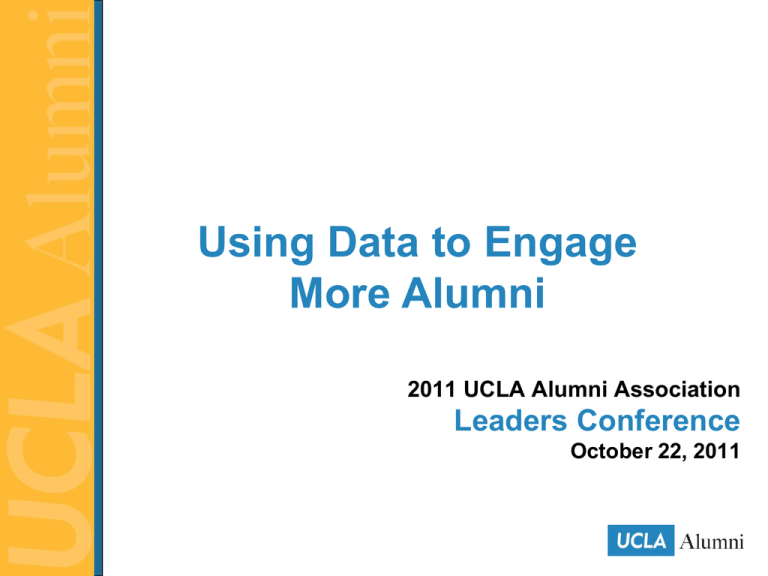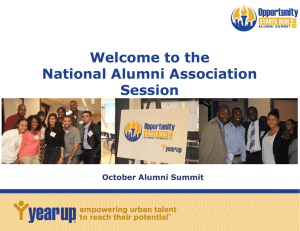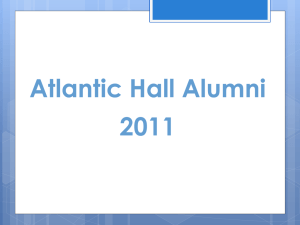Session Notes - UCLA Alumni Association
advertisement

Using Data to Engage More Alumni 2011 UCLA Alumni Association Leaders Conference October 22, 2011 Why is data important? ? Data… • Helps to understand the needs, perceptions and preferences of broader audience • Allows us to communicate information in a more appealing way • Assists us in developing programs and services that are attractive • Supports us in assessing current offerings to better engage more alumni Case Study: Data Informs Decision Making • Staff and volunteer leadership have limited perspective; must appeal to needs of broader audience • Research Findings • Please read XYZ Alumni Association Case Study Handout Case Study: Limited Perspective, Limits Opportunities Q: Thinking of future alumni reunions, rate the level of importance for a …? 50% 45% 40% 35% 30% 2000-2010 25% 1990-1999 1970-1989 20% 1950-1969 15% 10% 5% 0% 5-year 10-year 25-year 30-year 40-year 50-year Note: 1950 – 2010 represents graduation years Note: Percent calculated using a 6-point scale. Only very important and important ratings are represented in the graph Generational Traits Gen Yers Gen Xers Baby Boomers Silent Generation 1980-2001 1965-1979 1946-1964 1925-1945 Entitled Optimistic Civic-minded Close parental involvement Self-reliant Adaptable Cynical Distrusts authority Workaholic Idealistic Competitive Loyal Patriotic Dependable Conformist Respects authority Values work-life balance Resourceful Materialistic Rigid Impatient Entrepreneurial Seeks personal fulfillment Financially conservative Technology Savvy Technology Savvy Values titles Solid work ethic Multitasking Team oriented (Alsop, Ron. THE TROPHY KIDS GROW UP: how the millennial generation is shaking up the workplace, 2008) Case Study: Importance Data Q: To plan future alumni reunion events, rate the level of importance for the following…: Q: How likely are you to attend…? 70% 60% 50% 40% 3-day Reunion (Importance) 30% 3-day Reunion (Likelihood of Attending) 20% 10% 0% Local Non-local Internal Growth and Alignment AA Strategic Plan: Act with relentless attention to alumni needs. Manage by data-driven decisions. Monitor performance and respond to change • Overall Survey Studies - Segmentation – – • • • Readership Behavior (Age) Webster Readership Behavior (Open rate) Smaller Survey Studies – Segmentation – – – • Anderson Studies: Local/non-local; Travel, Arts & Entertainment, Sports & Athletics, Career-focused, Social Oriented Anderson Study: Currently in progress Engagement: Medical Alumni, SON, Political Science Events: ENN, IWAB, Spring Sing (S/A); D12 (S/A/Faculty) Staff: Core Activities & Engagement; Pulse Future Studies - Travel, Lake Arrowhead Conference Center, Career Services, Regional Affinities Anderson School Studies 1. Product and Services Survey 2. Behavioral Segmentation Study Goals: • Produce more satisfying events and offer greater value to alumni – keep them coming back • Better understanding of audience perceptions • Developed audience segments • Established benchmarks and better understand attitudes and expectations Behavioral Segments 2,000 random alumni respondents – 5% response rate Alumni Need Fulfillment Alumni Want: • Career networking • Bruin marketplace • Bruin Professionals and Bruin Professionals resource directory • Job board, job mentor and job preparation • Discounted rates for career counseling AA Responds: • BruinWorks –Alumni networking, marketplace, resume and job posting • Professional Development Team – assess needs not addressed by Career Center, create new services and programs based on specific needs • Hired Director, Bruin Careers 678 alumni respondents – 7% response rate UCLA Alumni Day Event Satisfaction Leads to Greater Long Term Participation First Timers (n = 150) 2nd Time Attending (n = 86) 3rd Time Attending (n = 100) 4th Time Attending (n = 42) 89% 74% 72% 76% Feelings of Connectedness 62% 66% 84% 88% Likelihood of Future Participation 73% 75% 79% 95% Overall Ratings* Overall Satisfaction *Note: Calculations are based on a 6-point metric scale. Survey results, as shown in the table, represent a calculation based on only the top two positive categories. Does Your Event Have a Buzz? Net Promoter Score A - Alumni S - Student RG - Recent Grad ["Very likely" % responses - All "unlikely" % responses = NP Score] 1.00 1.00 0.84 0.80 0.61 0.59 0.60 0.61 0.63 0.65 0.55 0.49 0.49 0.47 0.40 0.25 0.20 X 0.20 -0.06 -0.15 A) ng ( Ho me com i ( A) D1 2-R eg -H os ts ( S) G) (A) D1 2-L oc alHo s ts D1 2-S tud en ts (A/ R (A) D1 2-R eg Att en de e Co n fe r en ce Le ad er s ay 20 10 (A) UC LA D S in g( S) Sp rin g S in g( A) Sp rin g (A) IW AB EN N( S) EN N( A) (S) Gr ad Pa kL M (S) M Gr ad Pa kA Se nio r -0.20 Se nd off (S) 0.00 What does all this mean to you? Know your audience (Segmentation) • Local vs. Non-local • Travel, Arts & Entertainment, Sports & Athletics, Career Focused, Social Oriented • Communication – – – – Subject line testing Email content testing Open and click-through rates Interest testing • Affinity Connections • Demographics Affinity Connections Alumni: Athletics, UCLA Alumni Associations Recent graduates: Friends, campus, athletics, department or major Students: Friends, departments or major, campus, student groups Q: I primarily identify with UCLA through… 90% 80% 70% 60% 50% 40% 30% 20% 10% 0% Student (n=890) Recent Grads (144) Alumni (n=1799) CONFIDENTIAL 16 Generational Traits Gen Yers Time Span 1980-2001 Traits Entitled Optimistic Civic-minded Close parental involvement Values work-life balance Impatient Technology Savvy Multitasking Gen Xers Baby Boomers Silent Generation 1965-1979 Self-reliant Adaptable Cynical Distrusts authority 1946-1964 Workaholic Idealistic Competitive Loyal 1925-1945 Patriotic Dependable Conformist Respects authority Resourceful Materialistic Rigid Entrepreneurial Seeks personal fulfillment Values titles Financially conservative Solid work ethic Technology Savvy Team oriented (Alsop, Ron. THE TROPHY KIDS GROW UP: how the millennial generation is shaking up the workplace, 2008) Take Aways… Given the information presented: – What do you think are the biggest “Take Aways” from this information? – In what ways are you able to use this information with the alumni group you represent? Alumni Research Team + Next Steps: • Two person research team • Research team is guided by a research slate • Explore concept meetings • Develop ways to disseminate data Thank You Questions



